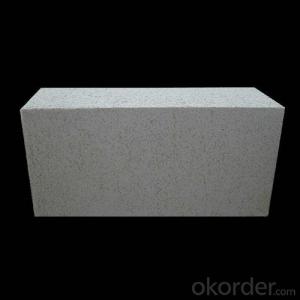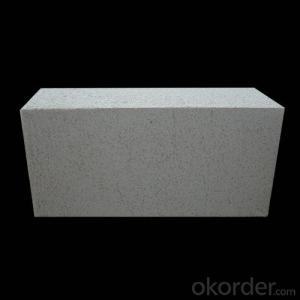FIRE High Temperature Refractory Insulating Firebrick
- Loading Port:
- Shanghai
- Payment Terms:
- TT OR LC
- Min Order Qty:
- 10 m.t.
- Supply Capability:
- 1000000 m.t./month
OKorder Service Pledge
OKorder Financial Service
You Might Also Like
nsulating Firebrick is made of high grade bauxite through high temperature calcinations. High alumina brick is a kind of neutral refractory material so that it enjoys excellent resistance
to acid and alkali corrosion. It has characteristic of high refractoriness under load, which decide high alumina brick is a n ideal material for various kinds of industrial furnace. It is widely
used in building lining of hot-blast stove, blast furnace, coke oven, rotary kilns of cement and so on.
characteristics: 1 Excellent thermal stability
2 High refractoriness under load
3 Chemical stability and anti-corrision
4 Small high temperature creep rate
5 Excellent thermal shock resistance
Typical Application: 1 Building materials for blast furnace
2 Building materials for hot-blast stove
3 Building materials for coke oven
4 Building materials for steel making furnace
5 Kiln car building
6 For ladle
Product Type: fireclay brick (SK 32, SK 34)
high alumina brick (sk 35-38)
Package: pallet, thermal shrinkage package
Technical Data
Item | Fireclay Brick | High Alumina Brick | |||||
SK32 | SK34 | SK35 | SK36 | SK37 | SK38 | ||
Al2O3 (%) ≥ | 38 | 42 | 48 | 55 | 65 | 75 | |
Refractoriness (oC) ≥ | 1670 | 1730 | 1750 | 1770 | 1790 | 1810 | |
Refractoriness under Load (oC) ≥ | 1250 | 1300 | 1420 | 1470 | 1500 | 1520 | |
Linear Change (%) (2h) | 1350 oC | 1350 oC | 1450 oC | 1500 oC | 1500 oC | 1500 oC | |
-0.5 | -0.5 | -0.4-+0.1 | -0.4-+0.1 | -0.4-+0.1 | -0.4-+0.1 | ||
Porosity (%) ≤ | 26 | 26 | 22 | 22 | 23 | 23 | |
Cold Crushing Strength, MPa ≥ | 15 | 20 | 39.2 | 44.1 | 49 | 53.9 | |

FAQ
Q1: How do you control the products quality?
A1: With strict quality control system throughout the materials selection and production process, our refractory and ceramic fiber products quality is effectively controlled to meet customer requirements.
From the raw materials selecting, our quality control begin. The quality certificates of raw materials are required and each batch will be tested before using. During production, the quality control are conducted by workers and then each piece will be sorted and examined by quality supervis
Q2: What`s the lead time for my order?
A2: It depends on customers’ requirements and our production schedule. And usually we need 30-60 days for refractory bricks,10-25 days for unshaped refractory materials and 10-20 days for ceramic fiber blankets.
Q3: Can you offer Door-to-Door delivery?
A3: Yes, but only for some countries such us U.S., UAE, Saudi Arabia, Iran, and Russia, etc.
Q4: What is the minimum quantity?
A4: There is no minimum order quantity. Depending on the item and processing, there may be a minimum production required, however we can offer a quotation based only on the quantity you need.
Q5: Can you give me a brief introduction of the application of your products?
A5: CNBM (China National Building Material) core refractory business comprises the production, sale and installation of high-grade refractory products, the development and implementation of customized system solutions as well as rendering outstanding services for the key industries in Glass, Iron& Steel, Petrochemical, Cement, Ceramic and Nonferrous Metals.
- Q:How much is a thermal brick?
- Insulation brick prices also have a great relationship with the material and workmanship, such as clay brick price is much lower than high alumina brick, mullite and corundum brick prices will be higher.
- Q:Do insulating fire bricks require any special fireproof coatings?
- No, insulating fire bricks do not require any special fireproof coatings. They are already designed to withstand high temperatures and provide insulation without the need for additional coatings.
- Q:Can insulating fire bricks be used for insulation in solar thermal systems?
- Yes, insulating fire bricks can be used for insulation in solar thermal systems. Insulating fire bricks are specially designed to have low thermal conductivity, which means they can effectively trap and retain heat. This makes them suitable for insulating the components of a solar thermal system, such as the solar collector and the storage tank, to minimize heat loss and increase the overall efficiency of the system. Additionally, insulating fire bricks are able to withstand high temperatures, which is crucial in solar thermal systems where temperatures can reach extremes. Overall, using insulating fire bricks for insulation in solar thermal systems can help improve their performance and reduce energy loss.
- Q:Can insulating fire bricks be used in the construction of fireplaces?
- Yes, insulating fire bricks can be used in the construction of fireplaces. Insulating fire bricks are designed to withstand high temperatures, making them an ideal choice for lining the interior of a fireplace. They have excellent thermal insulation properties, helping to retain heat within the fireplace and prevent excessive heat transfer to the surrounding structure. This not only improves the efficiency of the fireplace but also reduces the risk of damage to the surrounding walls. Insulating fire bricks are lightweight and easy to handle, making them convenient for construction purposes. Additionally, they are resistant to thermal shock, meaning they can withstand rapid temperature changes without cracking or breaking. Overall, insulating fire bricks are a reliable and effective choice for constructing fireplaces.
- Q:Can insulating fire bricks be used in the construction of glass bottle production furnaces?
- Yes, insulating fire bricks can be used in the construction of glass bottle production furnaces. Insulating fire bricks are designed to withstand high temperatures and provide excellent thermal insulation. They are often used in applications that require heat retention and energy efficiency, such as furnaces. By using insulating fire bricks in the construction of glass bottle production furnaces, the heat generated during the glass-making process can be effectively contained within the furnace, reducing heat loss and improving energy efficiency. This can result in cost savings and improved production performance. Additionally, insulating fire bricks can help protect the structural integrity of the furnace by minimizing thermal stress and preventing heat transfer to the surrounding environment. Overall, the use of insulating fire bricks in glass bottle production furnaces can contribute to more efficient and durable furnace operation.
- Q:What is the compressive strength of insulating fire bricks?
- The compressive strength of insulating fire bricks can vary depending on the specific composition and manufacturing process. However, in general, insulating fire bricks have a compressive strength ranging from 1 MPa (megapascal) to 10 MPa. This range is relatively low compared to other types of bricks due to their lightweight and porous nature, which is designed to provide excellent thermal insulation properties. It is important to note that the compressive strength of insulating fire bricks may not be as crucial as in structural bricks, as their main function is to provide insulation rather than structural support.
- Q:Are insulating fire bricks resistant to moisture penetration?
- Yes, insulating fire bricks are resistant to moisture penetration.
- Q:Can insulating fire bricks be used for soundproofing?
- Insulating fire bricks are primarily designed for high-temperature applications, such as lining kilns and furnaces, due to their ability to withstand extreme heat. While they do offer some level of sound insulation due to their dense composition, they are not specifically designed or recommended for soundproofing purposes. Insulating fire bricks are more effective at blocking heat transfer than sound transmission. For soundproofing purposes, other materials specifically engineered for acoustic insulation, such as mineral wool, fiberglass, or foam panels, are typically used. These materials are designed to absorb and dampen sound waves, providing better soundproofing results. Therefore, if your goal is to soundproof a space, it is recommended to use materials specifically designed for that purpose rather than relying on insulating fire bricks.
- Q:Can insulating fire bricks be used in both residential and industrial applications?
- Insulating fire bricks are versatile and suitable for both residential and industrial use. They provide thermal insulation, preventing heat loss and maintaining desired temperatures in various settings. In residential applications, these bricks enhance energy efficiency and reduce heat loss in fireplaces, wood-burning stoves, and kilns. In industrial environments, they are commonly used in furnaces, kilns, and high-temperature areas to insulate and prevent heat transfer. Additionally, they are utilized in constructing ovens, chimneys, and boilers in both residential and industrial settings. In summary, insulating fire bricks can be applied in numerous applications, making them suitable for both residential and industrial purposes.
- Q:Can insulating fire bricks be used in heat exchangers?
- Yes, insulating fire bricks can be used in heat exchangers. These bricks are designed to have excellent thermal insulation properties, making them suitable for applications where heat needs to be contained or transferred efficiently. Heat exchangers rely on the efficient transfer of thermal energy, and insulating fire bricks can help in reducing heat loss or gain in these systems, improving their overall efficiency.
1. Manufacturer Overview |
|
|---|---|
| Location | |
| Year Established | |
| Annual Output Value | |
| Main Markets | |
| Company Certifications | |
2. Manufacturer Certificates |
|
|---|---|
| a) Certification Name | |
| Range | |
| Reference | |
| Validity Period | |
3. Manufacturer Capability |
|
|---|---|
| a)Trade Capacity | |
| Nearest Port | |
| Export Percentage | |
| No.of Employees in Trade Department | |
| Language Spoken: | |
| b)Factory Information | |
| Factory Size: | |
| No. of Production Lines | |
| Contract Manufacturing | |
| Product Price Range | |
Send your message to us
FIRE High Temperature Refractory Insulating Firebrick
- Loading Port:
- Shanghai
- Payment Terms:
- TT OR LC
- Min Order Qty:
- 10 m.t.
- Supply Capability:
- 1000000 m.t./month
OKorder Service Pledge
OKorder Financial Service
Similar products
New products
Hot products
Related keywords



























